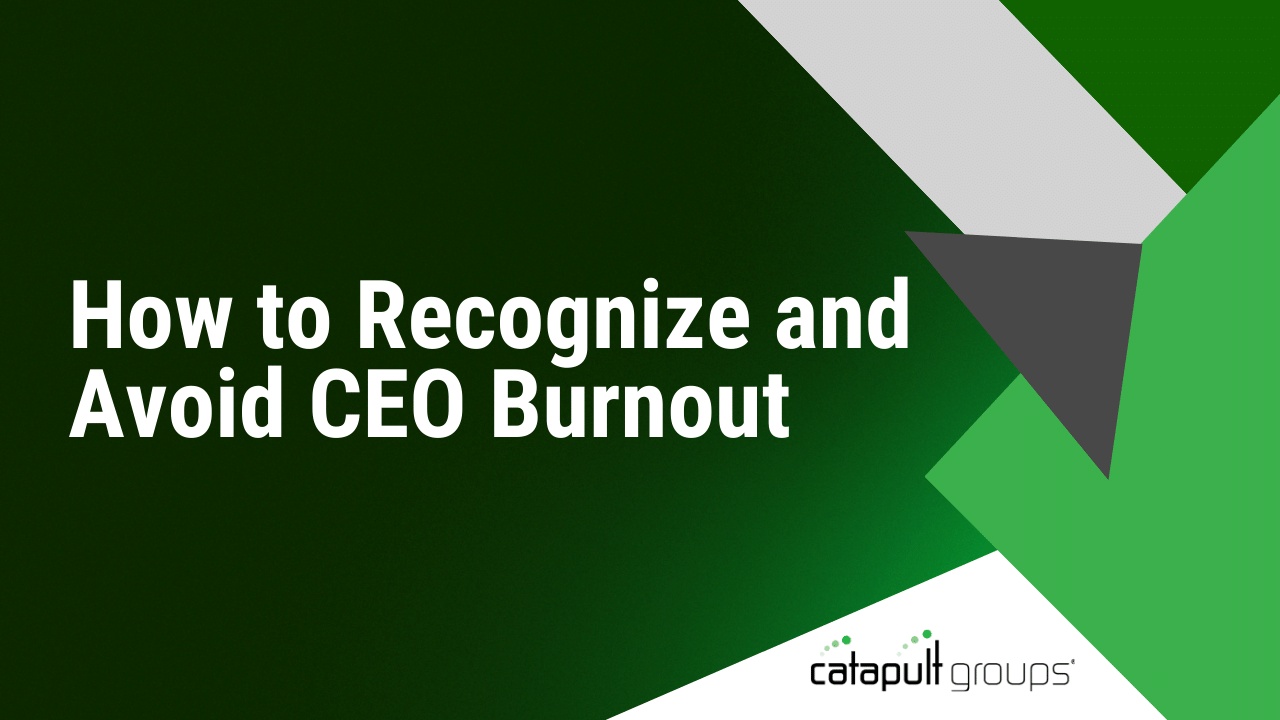How to Recognize and Avoid CEO Burnout
CEO burnout can be a tricky thing to self-diagnosis. Days, weeks, even months may go by before a CEO or business owner recognizes that he or she is overly stressed, close to the end of their tether, and exhibiting behavior that adversely impacts the workplace.
Compounding the problem is the tendency among many A-type personalities never to admit that they have reached a stage of burnout and may need help repairing the damage.
But not recognizing signs of burnout and/or declining to address them can put virtually everything in the business at risk. Why? Because burnout leads to exhaustion and poor decision-making, which in turn threatens a company’s well-being (and that of its employees). In a state of burnout, it’s not easy to see things clearly, or to apply one’s well-honed capacity to analyze an issue and resolve it.
And when these leadership traits are compromised, bad things can happen.
Want to meet other CEOs and trade strategies to avoid burnout?
Join one of our MasterMind Groups to connect with your peers.
Signs and symptoms of burnout
When it comes to “leadership fatigue,” certain indicators are common across the board. Take a look at problems that frequently occur and see which, if any, describe what you might be going through.
Personal health issues. Regardless of what some CEOs and business owners believe, no one is immune to stress-related health problems. These can range from lack of appetite or over-eating to confusion and forgetfulness, depression or simply not feeling “up to par” on a daily basis. If, for example, you’re constantly in need of strong coffee to stay alert or experience doziness during an important meeting, your body’s saying you’re not getting enough sleep.
Difficulties interacting with others. Stress often manifests itself in episodes of impatience with others and/or behaving poorly in what are otherwise everyday interactions. In some worst-case scenarios, executives might find themselves yelling at assistants, typing out irate emails (that should never be sent) or getting mired in trivial office politics.
Lapse in motivation. Burnout often manifests itself in a marked lack of enthusiasm for things you previously cared a great deal about. “You may complete tasks, and even complete them well, but the motivation that used to drive you is gone,” Forbes notes. Rather than being satisfied with your achievements, work is no longer satisfying “because no matter what you’re putting into your job, you don’t feel like you’re getting much out of it.”
Never not thinking about work. It’s not just a matter of taking work home with you at night. It’s realizing that thoughts about your business are almost always present, even when you’re supposedly engaged in family and recreational activities. Then there’s the accompanying anxiety (How will I meet the deadline I imposed on myself? What if I’m forgetting some crucial detail?)—thoughts that spiral around in a loop that never lets up. If you wake up in the morning not feeling at all refreshed, this might be a good reason why.
All of these symptoms can manifest themselves to a small degree as part of a business leader’s average day. But when they become the norm, rather than the exception, full-scale burnout could be just around the corner.
What to do to avoid or minimize burnout
Fortunately, there are several actions a CEO or business leader can take to offset these troubling signs of burnout.
Hire the best people out there. When you assemble a team of talented, ambitious, and driven individuals, you take a considerable amount of pressure off yourself. It’s no longer necessary to think you must do everything yourself, or even sign off on everything others do. Instead, you trust your team to get it—to know what has to be done, without running to you all the time for guidance and advice.
As we’ve noted elsewhere, “By surrounding yourself with great people, not only do you get better results, but you also get to spread out the workload.”
Prioritize your mental and physical well-being. You know all those high priorities you’ve set for yourself in your business? In fact, they should take second place behind prioritizing your own health. This includes:
- Eating healthy food
- Getting sufficient sleep
- Finding time to exercise
- Socializing with “civilians” (i.e., non-employees and work colleagues)
Unplug! Even the most “device-dependent” individuals recognize that an addiction to mobile devices and social media is unhealthy. Entrepreneur Kelley Sanabria, a self-proclaimed “social media addict,” offers helpful tips on unplugging from the internet in order to achieve a healthier balance between work and life:
- Put your phone on silent mode. This way, she writes, “I control when I engage it, it doesn’t control me.”
- Stop relying on notification badges. Your apps notify you when messages arrive, but that doesn’t mean you’re legally mandated to stop whatever you’re doing to view them. Turn off the notification badges and select a particular time of day when you review what’s come in.
- Relocate apps. Did you know you can move apps to a second screen or elsewhere on your phone? Try doing this, so these and bothersome social media apps aren’t the first thing you spot when you unlock the phone.
- Choose a dedicated time to engage in social media. Generally speaking, CEOs and business owners are far too busy to spend much time on social media during the day. That doesn’t stop them from doing so, since it can be immediately gratifying (and frustrating), thus drawing you in further. Try closing Twitter and Facebook on your browser and setting aside no more than a half-hour a day to checking social media feeds. You’ll feel better for it!
Overcome your aversion to delegate. It’s a common refrain among members of Catapult Groups and their Business Coaches–business owners and CEOs grappling with the notion that “I’m the only one who can do things the right way.” It’s a surefire formula for burnout. The simple answer is, learn to delegate.
As we’ve suggested in past communications:
- Delegate responsibilities everywhere you can, particularly in areas of business that need attention, but not your personal attention.
- Authorize individuals to make decisions on their own. Much more gets accomplished when your staff has the autonomy to make decisions in certain agreed-upon situations.
Perhaps the best alternative to leadership burnout is joining a strong peer advisory organization like Catapult Groups. In small groups of 12-16 business owners (all of whom lead non-competing entities), members meet once a month for half-day workshops led by world-class trainers, followed by a half-day group session where members present issues or opportunities they’re working on, and receive expert peer advice, suggestions and guidance.
Meeting with others like yourself who want to continue working hard and avoid burnout can help immensely. But the only way to know for sure is by exploring the benefits of Catapult Groups for yourself. Contact us today for a free consultation and see if we have the right solution for your business!



